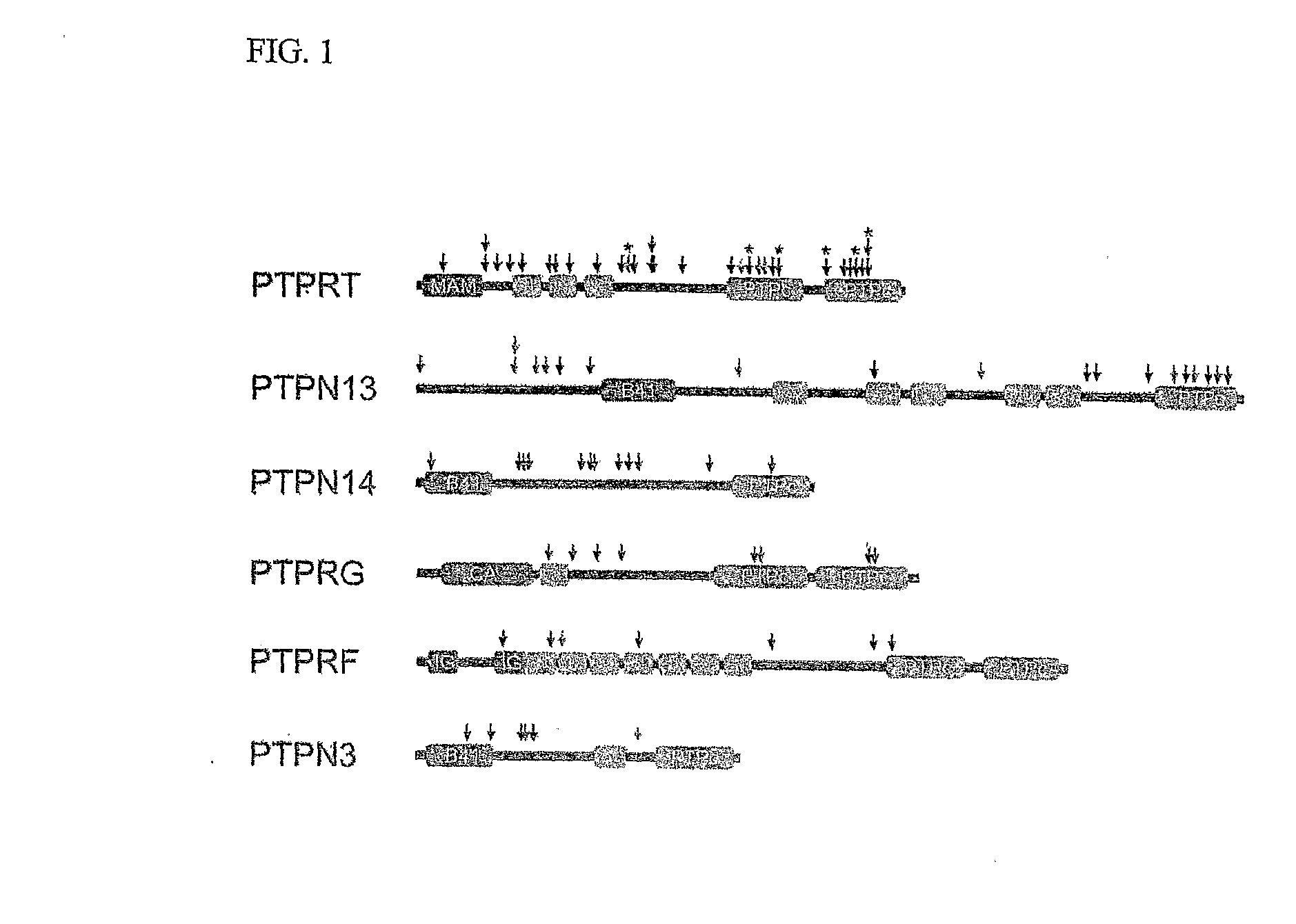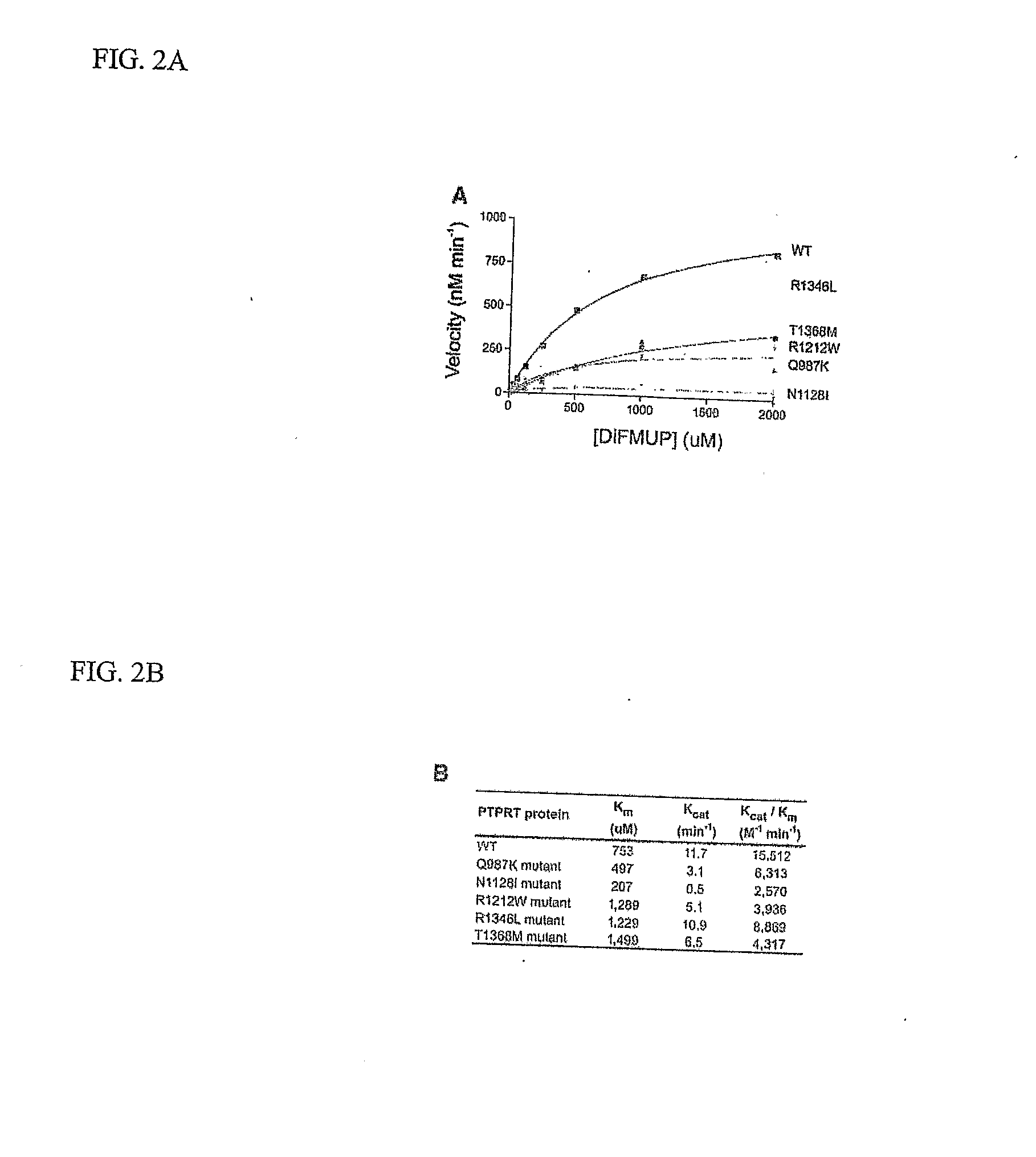Protein Tyrosine Phosphate Mutations in Cancers
a technology of tyrosine phosphate and cancer, applied in the field of cancer, can solve the problems of not knowing how many or how frequently members of the ptp gene family are altered
- Summary
- Abstract
- Description
- Claims
- Application Information
AI Technical Summary
Benefits of technology
Problems solved by technology
Method used
Image
Examples
example 1
Identification of PTP Gene Superfamily Members
[0034] We employed a combination of Hidden Markov Models representing catalytic domains of members of the PTP superfamily to identify 53 classical PTPs (21 RPTPs and 32 NRPTPs), 33 DSPs, and one LMP in the human genome (12). This analysis revealed a set of genes representing all known human PTPs (13) as well as seven putative PTPs.
example 2
Identification of PTP Gene Superfamily Members With Mutations
[0035] As an initial screen to evaluate whether these phosphatases are genetically altered in human cancer, we analyzed the coding exons of all 87 members of this gene family in 18 colorectal cancers. A total of 1375 exons from all annotated RPTPs, NRPTPs, DSPs and LMPs were extracted from genomic databases (12). These exons were PCR-amplified from cancer genomic DNA samples and directly sequenced using dye terminator chemistry (12). Whenever a presumptive mutation was identified, we attempted to determine whether it was somatically acquired (i.e., tumor specific) by examining the sequence of the gene in genomic DNA from normal tissue of the relevant patient.
[0036] From the 3.3 Mb of sequence information obtained, we identified six genes containing somatic mutations, including three members of the RPTP subfamily (PTPRF, PTPRG, and PTPRT) and three members of the NRPTP subfamily (PTPN3, PTPN13 and PTPN14). These six genes...
example 3
Analysis of Mutation Types
[0038] Analysis of mutations in tumors is complicated by the fact that mutations can arise either as functional alterations affecting key genes underlying the neoplastic process or as non-functional “passenger” changes. The multiple waves of clonal expansion and selection that occur throughout tumorigenesis lead to fixation of any mutation that had previously occurred in any predecessor cell, regardless of whether the mutation was actually responsible for the clonal expansion. Two independent lines of evidence suggest that the sequence alterations we observed are functional. First, the ratio of nonsynonymous to synonymous mutations provides an indication of selection, as synonymous alterations usually do not exert a growth advantage. There were no somatic synonymous mutations detected in the colorectal cancers analyzed, resulting in a ratio of nonsynonymous to synonymous mutations of 77 to 0, much higher than the expected 2:1 ratio for non-selected passeng...
PUM
| Property | Measurement | Unit |
|---|---|---|
| Molar density | aaaaa | aaaaa |
| Force | aaaaa | aaaaa |
| Therapeutic | aaaaa | aaaaa |
Abstract
Description
Claims
Application Information
 Login to View More
Login to View More - R&D
- Intellectual Property
- Life Sciences
- Materials
- Tech Scout
- Unparalleled Data Quality
- Higher Quality Content
- 60% Fewer Hallucinations
Browse by: Latest US Patents, China's latest patents, Technical Efficacy Thesaurus, Application Domain, Technology Topic, Popular Technical Reports.
© 2025 PatSnap. All rights reserved.Legal|Privacy policy|Modern Slavery Act Transparency Statement|Sitemap|About US| Contact US: help@patsnap.com



